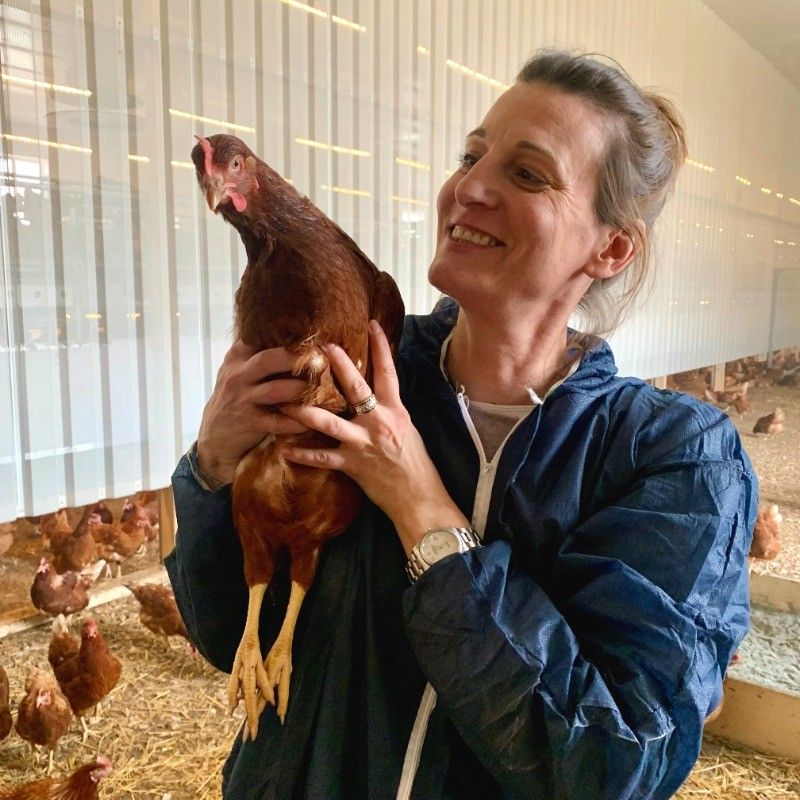-
-
Auditorium
- What is the EU Commission’s long-term vision for agriculture and food policy, and how does it specifically address the future of livestock and animal agtech?
- How can EU policy boost uptake of improved and innovative practices to optimise manure management?
- How will policy help advance digitalisation in animal farming, technologies like precision livestock tools, robotics, AI, and IoT?
- How will the Commission accelerate regulatory pathways for technologies impacting animal production, such as biopesticides and new genomic techniques for feed?
- How are income diversification tools — such as carbon farming, nature credits, and renewable energy production — expected to benefit animal agriculture specifically?
-
Auditorium
- How are food companies partnering with beef and dairy supply chains to build shared frameworks for on-farm data capture, carbon footprinting, and biodiversity monitoring?
- What role do emerging agtech tools play in supporting structured farm transition plans, and how can they enable credible monitoring, reporting, and verification (MRV) of emissions reductions?
- What are the shared challenges food companies face in meeting SBTi validated FLAG targets and how can businesses overcome them?
- What practical barriers prevent farmer engagement in sustainability data efforts—especially for companies positioned mid-chain—and how are industry leaders successfully addressing them?
- Which incentive models—financial, technical, or otherwise—are proving most effective in driving measurable carbon reductions at the farm level?
Speakers -
Auditorium
- How are UK supermarkets leading cross-sector collaboration to drive supply chain decarbonisation?
- In what ways can AI-powered LCA platforms support retailers in tackling Scope 3 emissions at scale?
- How are supermarket-driven initiatives shaping future government policy on emissions reporting and environmental labelling?
- What approaches can the grocery sector take to incorporate farm-stage carbon data for product footprints?
- What is the potential for scaling or replicating this model in other geographical or regulatory contexts?
-
Exhibition & Networking Area
-
Auditorium
- Can AI help feed companies stay compliant with fast-evolving regulations and improve customer service at the same time?
- How can we bridge the gap between data science and animal nutrition to unlock AI's full potential across the feed value chain?
- How can AI’s precision optimization in feed formulation help ensure perfectly balanced diets, minimize nutrient waste, and improve animal performance, leading to healthier animals and higher yields?
- In what ways can AI’s ability to dynamically adjust formulations in real time and increase scalability benefit feed manufacturers by improving cost efficiency, speed, and adaptability in an increasingly volatile market?
Chairperson -
Auditorium
- How is AI informing decision-making in livestock farming, and what are the implications for farmer autonomy and human oversight?
- How can automation reduce labour costs and increase farm efficiencies?
- In what ways do sensors and digital tools enable real-time monitoring and predictive analytics to detect monogastric or ruminant health issues early and improve disease management?
- How can AI-driven technologies enhance productivity through behavioural analysis, and weight tracking?
- What are the main challenges and opportunities in scaling precision livestock farming tools from pilot projects to widespread commercial adoption in animal agriculture?
Chairperson -
Exhibition & Networking Area
-
Auditorium
Presentations on using MRI and AI technology for in-ovo sexing, impact of AI and big data for AMR surveillance, and AI-powered real-time cow health insights.
-
Auditorium
- What are the potential welfare implications of using gene editing in animals, and how can benefits be weighed against possible risks?
- To what extent is it ethically appropriate to apply gene editing for different purposes, such as production, therapeutics, or disease control?
- How can gene editing contribute to sustainability in agriculture?
-
Auditorium
Join focused, interactive discussion groups to deep dive into the specific topics that are most relevant to you and your business.
Animal Vaccines Work—So Why Aren’t We Using Them?
Host: Carel du Marchie Sarvaas, Executive Director, HEALTHFORANIMALSSmart Tech, Ethical Choices: AI in Animal Husbandry
Host: Andrea Rosati, Secretary General, EUROPEAN FEDERATION OF ANIMAL SCIENCEAnimals in The Loop: Unlocking Their Role in a Circular Agri-food System
Host: Dr. Gert van Duinkerken, Director, WAGENINGEN LIVESTOCK RESEARCHHow Can Breeding Help Shape the Future of Animal Farming?
Host: Çağla Kaya, EU Program Lead, EUROPEAN FORUM OF FARM ANIMAL BREEDERS (EFFAB) -
Exhibition & Networking Area
-
Auditorium
- How does the microbiome influence health and performance outcomes in pigs and poultry?
- What are the most effective ways to simplify microbiome management for producers without losing impact?
- How can early-life nutrition and feeding strategies be used to positively steer the microbiome?
- In what ways are prebiotics, probiotics and synbiotics, enzymes, organic acids and phytogenics effective in managing gut health in pigs and poultry?
- What are the challenges and opportunities with on-farm hatching, and what do field results show?
Chairperson -
Auditorium
Four start-ups, ranging from early-stage to Series C, will outline how they drive innovation in precision livestock farming, sustainability, animal health, and welfare. Each founder will share their company’s vision, progress, and strategic roadmap, with a panel of expert investors. The session will conclude with an interactive audience Q&A, offering a deeper dive into the challenges and opportunities shaping the future of animal agtech.
-
Auditorium
- What structural changes are needed in the investment ecosystem to close the growth capital gap for animal agtech companies stuck between venture and private equity stages?
- How can we raise the bar for investor sophistication in agtech, and what sector-specific knowledge or advisory frameworks are essential to enhance due diligence and reduce risk?
- Given the high early-stage valuations that have limited exit options, what lessons should investors take from the past decade, and how should current valuations be adjusted to align with market realities and scalability?
- Where is the most untapped investment potential within the animal health space—across diagnostics, therapeutics, genetics, and vaccines—and what are the key barriers to scaling innovation in these areas?
- What role can the finance industry play in accelerating the adoption of methane reduction solutions in the livestock sector?
-
Exhibition & Networking Area
-
Auditorium
Join us for a morning of networking and discussion, highlighting inspiring women leaders in the livestock industry.
-
Auditorium
- How is climate change expanding the threat of livestock diseases like bluetongue and African Swine Fever across Europe?
- What lessons can be learned from recent outbreaks of avian influenza, foot-and-mouth disease, and others to strengthen EU response?
- How can early warning systems, improved diagnostics, and real-time disease surveillance improve outbreak prevention and control?
- How effective is vaccination in the field and what roles do vaccines, farm-level biosecurity, and genetic innovation play in building healthier, more resilient herds?
- What coordinated strategies and partnerships are needed to embed animal health in EU policy and boost cross-sector collaboration?
-
Auditorium
- How can we accelerate vaccine innovation to respond rapidly to emerging animal diseases?
- In what ways can vaccine R&D keep pace with diseases like Epizootic haemorrhagic disease (EHD) that spread quickly through vectors like mosquitos and change epidemiologically by season and region?
- What are the main regulatory, logistical, and strategic challenges in moving animal vaccines from emergency use to full marketing authorization across multiple regions - and how can cross-border alignment be improved to ensure faster and more consistent vaccine access?
- Could a next-generation vaccine against African Swine Fever (ASF) virus pave the way for global eradication of the disease?
- Could 'plug and play' veterinary vaccine platforms, built on advanced technologies and a One Health approach, deliver safe, scalable, and cost-effective vaccines for animals and humans?
-
Auditorium
- Who should bear the cost of methane-reducing feed additives, and how can these innovations become financially viable for farmers and supply chains?
- What role does feed optimization and selective breeding for feed efficiency play in reducing methane while boosting animal productivity and profitability?
- What is the long-term promise of methane-reducing cattle vaccines, and how do we overcome the research, regulatory, and commercialization delays involved?
- How can manure management strategies — such as digesters, solid-liquid separation, and acidification — contribute to lower emissions and improved farm efficiency?
- Could industry and government collaboration — through public-private partnerships — accelerate adoption of effective methane abatement tools?
-
Exhibition & Networking Area
-
Auditorium
Emerging founders pitch novel tech across livestock, animal health, climate, and ag data.
Short pitches + live Q&A with investors and industry leaders. -
Auditorium
- Why is biodiversity reporting more complex than carbon reporting, and why can’t it rely on a single universal unit?
- How can businesses use a multi-metric approach to capture the full scope of their impacts and dependencies on nature?
- How can we reliably detect land-use change across global agricultural supply chains?
- What makes a biodiversity metric effective, and how do we ensure accuracy in satellite-based land-cover reporting?
- Why should organizations start building biodiversity data systems now, and how can prompt action create long-term ESG and compliance advantages?
Speakers -
Auditorium
- What does regenerative agriculture mean in the context of dairy farming, and how is it being practically implemented across the UK and Europe?
- How do regenerative dairy systems compare to high-input, high-output models in terms of profitability, resilience to input price shocks, and extreme weather impacts?
- What technological innovations — from soil monitoring to pasture management — can support regenerative practices at scale in livestock systems?
- How can the dairy supply chain evolve to share financial and climate-related risks more fairly between farmers, processors, and retailers?
- How can consumers, corporates, and agtech innovators contribute to a scalable, economically viable regenerative transition in livestock systems?
-
Exhibition & Networking Area
-
Auditorium
- Should emissions be taxed at the production stage or the consumption stage to effectively reduce agricultural GHG emissions?
- How could VAT reforms based on food products’ GHG intensity shift consumer behaviour and reduce emissions?
- How can food-related climate taxes be designed to avoid disproportionately affecting lower-income households?
- What would be the potential impacts of agricultural taxation on EU producer competitiveness, and how could carbon leakage be avoided?
- How could an EU Emissions Trading System (AgETS) be effectively implemented to tackle agricultural emissions, considering the sector’s complexity and specific challenges?
-
Auditorium
- What innovative approaches can be used to ensure the optimal use of food and beverage industry side streams co-products like brewers’ grain, steamed potato peels or wheat stillage for feed rather than diverting them to biogas production?
- How can collaboration between retailers, feed companies, and co-product suppliers close the nutrient cycle and contribute to the circular economy?
- How can solid-state fermentation unlock nutrients in low-value by-products, improving their nutritional characteristics, digestibility, and safety for use in pig and poultry feed?
-
Auditorium
- How have companies used the EUDR postponement period to build stronger sustainability strategies despite ongoing uncertainty?
- With 70% of compliance obligations still in place, what do the streamlined rules change for business operations and legal risk?
- What tools and strategies are helping companies overcome persistent traceability and data system challenges?
- How can partnerships seek to bridge the gap between regulatory commitments and effective action on the ground?
- What did EUDR dry runs in Brazil reveal about the readiness of soy and beef exporters - and the practical challenges they face?
Newsletter Sign-Up
Stay up-to-date with event news, opportunities, and announcements by subscribing to our newsletter.
)

















































)